Marrying Vega and Zen: The AMD Ryzen 5 2400G Review
by Ian Cutress on February 12, 2018 9:00 AM ESTiGPU Gaming Performance, Continued
Rise of the Tomb Raider
One of the most comprehensive games in the gaming benchmark suite is Rise of the Tomb Raider (RoTR), developed by Crystal Dynamics, and the sequel to the popular Tomb Raider which was loved for its automated benchmark mode. But don’t let that fool you: the benchmark mode in RoTR is very much different this time around.
Visually, the previous Tomb Raider pushed realism to the limits with features such as TressFX, and the new RoTR goes one stage further when it comes to graphics fidelity. This leads to an interesting set of requirements in hardware: some sections of the game are typically GPU limited, whereas others with a lot of long-range physics can be CPU limited, depending on how the driver can translate the DirectX 12 workload.

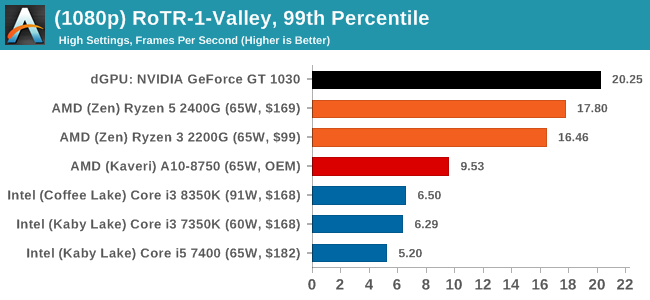
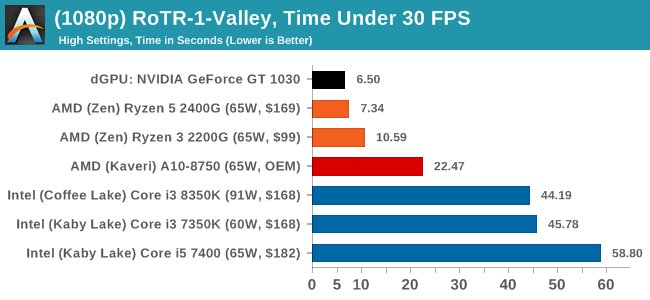
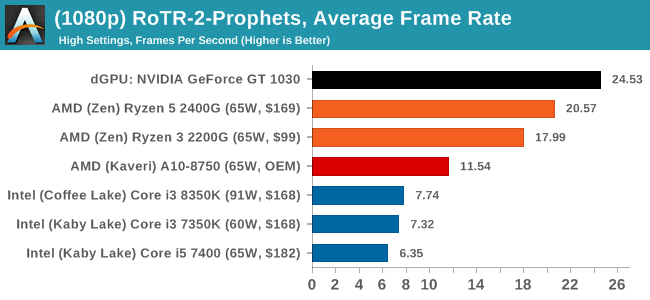
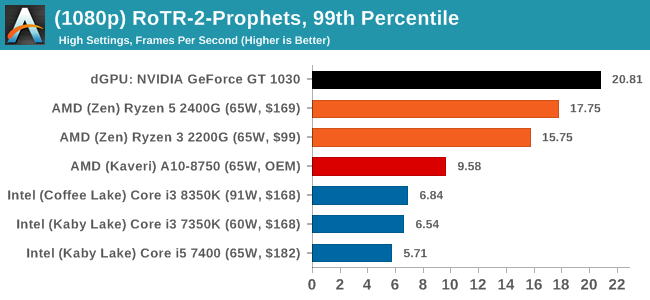
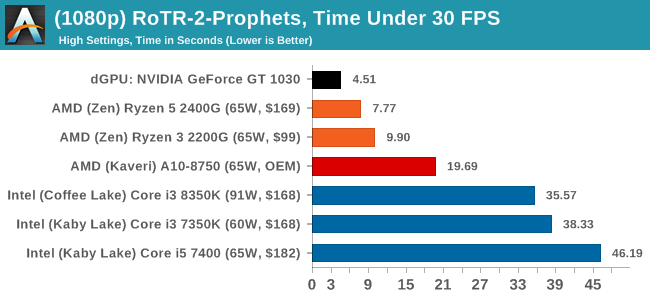

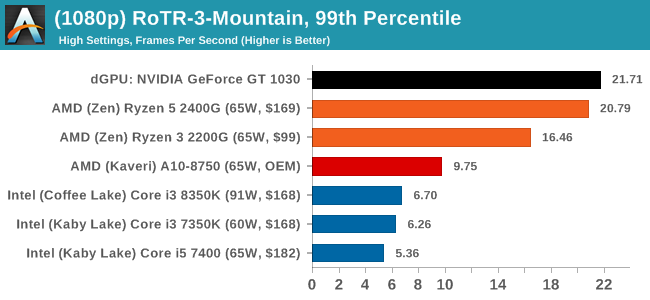
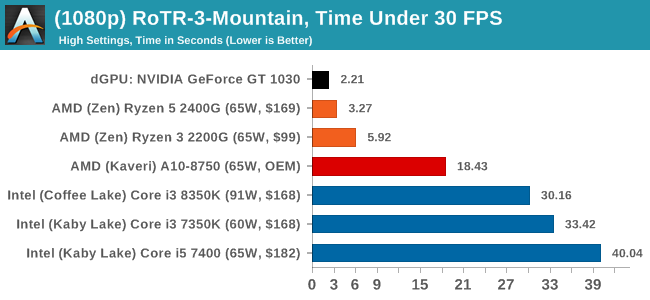
The GT 1030 sweeps the top spot against AMD here, though only by small margins most of the time. The AMD APUs still offer a commanding 2-3x performance jump over Intel's product line, and even more when price is factored into the equation.
Rocket League
Hilariously simple and embodying the elements of pick-up-and-play, Rocket League allows users to jump into a game with other people (or bots) to play football with cars with zero rules. The title is built on Unreal Engine 3, which is somewhat old at this point, but it allows users to run the game on super-low-end systems while still taxing the big ones. Since the release in 2015, it has sold over 5 million copies and seems to be a fixture at LANs and game shows. Users who train get very serious, playing in teams and leagues with very few settings to configure, and everyone is on the same level. Rocket League is quickly becoming one of the favored titles for e-sports tournaments, especially when e-sports contests can be viewed directly from the game interface.
With Rocket League, there is no benchmark mode, so we have to perform a series of automated actions, similar to a racing game having a fixed number of laps. We take the following approach: Using Fraps to record the time taken to show each frame (and the overall frame rates), we use an automation tool to set up a consistent 4v4 bot match on easy, with the system applying a series of inputs throughout the run, such as switching camera angles and driving around.
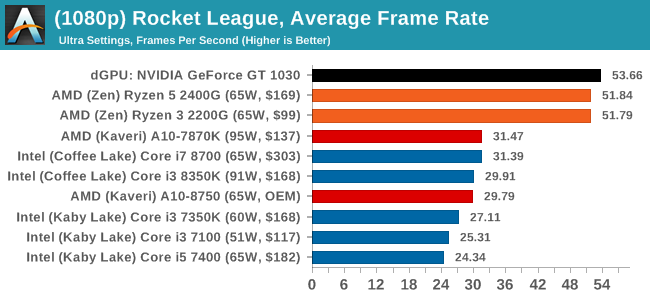
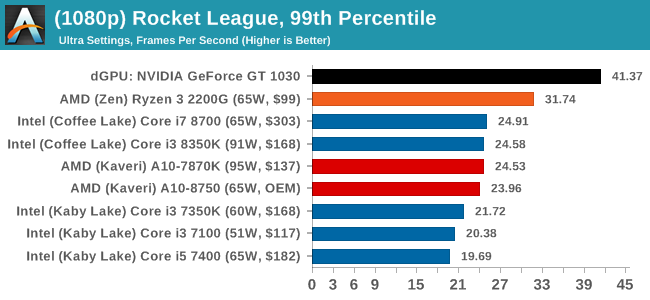

As the more eSports oriented title in our testing, Rocket League is less graphically intense than the others, and by being built on DX9, also tends to benefit from a good single thread performance. The GT 1030 wins again here, most noticably in the 99th percentile numbers, but the AMD chips are hitting 30 FPS in that percentile graph, whereas in the last generation they were getting 30 FPS average. That is a reasonable step up in performance, aided both to the graphics and the high-performance x86 cores. It will be interesting to see how the memory speed changes the results here.










177 Comments
View All Comments
sonicmerlin - Tuesday, February 13, 2018 - link
Now if only AMD had a competent GPU arch. The APU performance could be given a huge boost with Nvidia’s techdr.denton - Thursday, February 15, 2018 - link
They do. It's called Vega. Very efficient in mid- to low range and compute, and if I'm not mistaken that's where the money is. Highend gaming is just wi**ie waving for us geeks.HStewart - Tuesday, February 13, 2018 - link
Check out performance of up and coming i8809G with Vega Graphics compare to Ryzen 7http://cpu.userbenchmark.com/Compare/Intel-Core-i7...
Keep in mine this is a mobile chips - this is new mobile chips is quite powerful - I thinking of actually getting one - only big concern is compatibility with Vega chip.
haplo602 - Wednesday, February 14, 2018 - link
the i8809G is a desktop chip, 100W TDP ....hansmuff - Tuesday, February 13, 2018 - link
Any idea where I could buy the MSI B350I Pro AC? I have searched every retailer I've ever bought from and can not find the damn thing. I'm hoping it can run a 2400G out of the box, at least to update to the newest BIOS.Dragonstongue - Tuesday, February 13, 2018 - link
they REALLY should not have cut back the L3 cache SO MUCH...beyond that, truly are amazing for what they are...they should have also made a higher TDP version such as 125-160w so they could cram more cpu cores or at very least a more substantial graphics portion and not limit dGPU access to 8x pci-e (from what I have read)Graphics cards and memory are anything but low cost.
2200 IMO is "fine" for what it is, the 2400 should have had at least 4mb l3 cache (or more) then there should have been "enthusiast end" with the higher TDP versions so they could more or less ensure someone trying to do it "on a budget" really would not have to worry about getting anything less than (current) RX 570-580 or 1060-1070 level.
many cpu over the years (especially when overclocked) had a 140+w TDP, they could have and should have made many steps for their Raven Ridge and not limit them so much..IMO...they could have even had a frankenstein like one that has a 6pin pci-e connector on it to feed more direct power to the chip instead of relying on the socket alone to provide all the power needed (at least more stable power)
AM4 socket has already been up to 8 core 16 thread, and TR what 16 core 32 thread says to me the "chip size" has much more room available internally to have a bigger cpu portion and/or a far larger GPU portion, now, if they go TR4 size, TR as it is already has 1/2 of it "not used" this means they could "double up" the vega cores in it to be a very much "enthusiast grade" APU, by skimping cost on the HBM memory and relying on the system memory IMO there is a vast amount of potential performance they can capture, not to mention, properly designed, the cooling does not really become an issue (has not in the past with massive TDP cpu afterall)
anyways..really is very amazing how much potency they managed to stuff into Raven Ridge, they IMO should not have "purposefully limited it" especially on the L3 cache amount, 2mb is very limiting as far as I am concerned especially when trying to feed 4 core 8 thread at 65w TDP alojng with the gpu portion.
Either they are asking a bit much for the 2400g or, they are asking enough they just need to "tweak" a bit more quickly to make sure it is not bottlenecking itself for the $ they want for it ^.^
either way, very well done....basically above Phenom II and into Core i7 level performance with 6870+ level graphics grunt using much less power...amazing job AMD...Keep it up.
SaturnusDK - Wednesday, February 14, 2018 - link
Well done AMD. Well done.Both these APUs are extremely attractive. The R5 just screams upgradable. You get a very capable 4 core / 8 thread CPU packaged with an entry level dGPU for less than the competition charges for the CPU (with abyssmal iGPU) alone. In the current market with astronomical, even comical, dGPU prices this is a clear winner for anyone wanting to build a powerful mid-tier system but doesn't have the means to fork out ridiculous cash for higher tier dGPU now.
The R3 scream HTPC or small gaming box. A good low end CPU paired with a bare bones but still decently performing iGPU. Add MB, RAM, PSU, and HDD/SSD and you're good to go. I imagine these will sell like hot cakes in markets with less overall GDP and in the brick'n'mortar retail market.
The question is now. Is Intel ever going to produce a decent iGPU for the low end market? They've had plenty of time to do so but before Ryzen, AMD APUs just wasn't that attractive. Now though, you really have to think hard for a reason to justify buying a low end Intel CPU at all.
yhselp - Wednesday, February 14, 2018 - link
"Now with the new Ryzen APUs, AMD has risen that low-end bar again."You had to do it. I understand. And thank you.
dr.denton - Thursday, February 15, 2018 - link
<3Hifihedgehog - Wednesday, February 14, 2018 - link
I have been doing some digging and found that although current-generation AM4 motherboards lack formal HDMI 2.0 certification, just like many HDMI 1.4 cables will pass an HDMI 2.0 signal seamlessly without a hitch, the same appears to be the case for these boards whose HDMI traces and connectors may indeed be agnostic to the differences, if any. Could you do a quick test to see if HDMI 2.0 signals work for the Raven Ridge APUs on the AM4 motherboards you have access to? For further reference on the topic, see this forum thread “Raven Ridge HDMI 2.0 Compatibility — AM4 Motherboard Test Request Megathread” at SmallFormFactor.